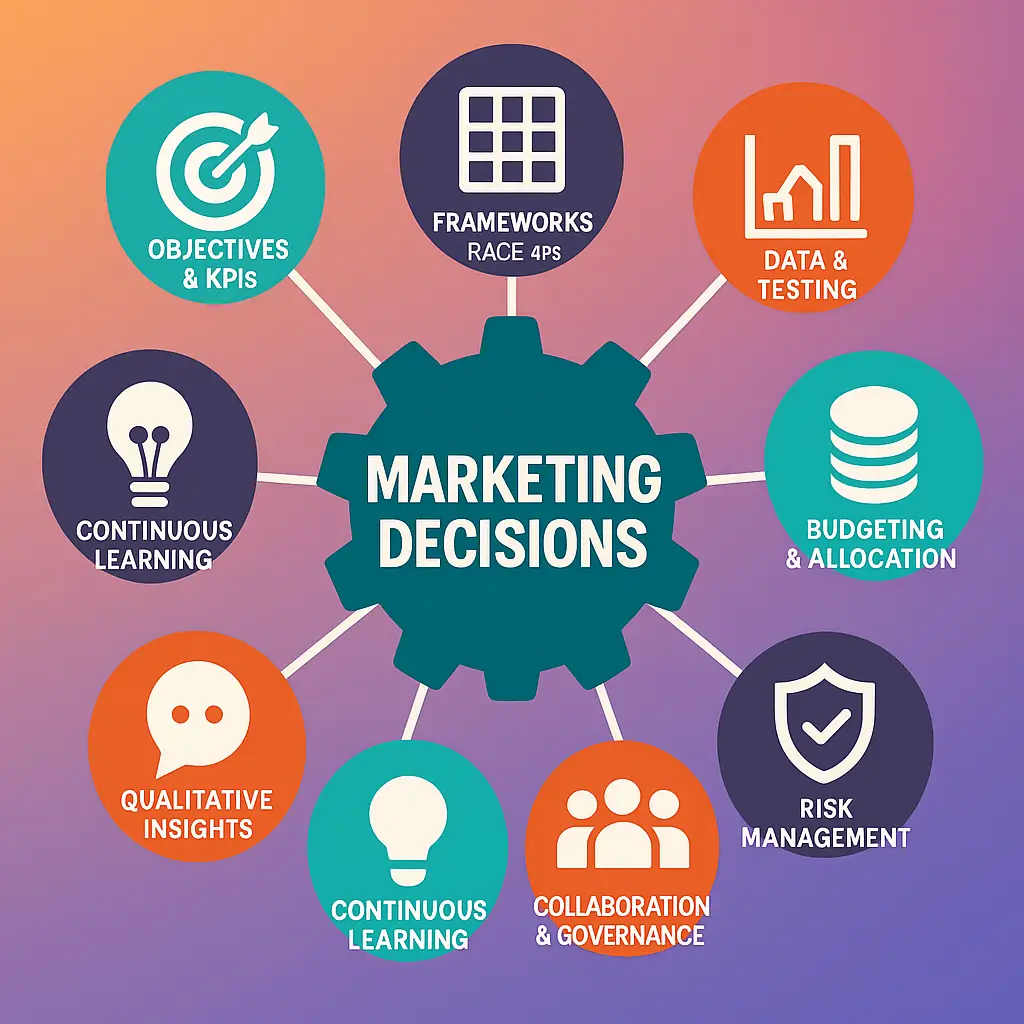Introduction
Every marketing campaign and strategy hinges on a series of decisions: Which audience to target? What message to craft? Which channel mix to allocate budget? Making these choices effectively can mean the difference between wasted spend and measurable growth. This article outlines key frameworks, data-driven practices, and practical tips to guide marketing decision-making under uncertainty.
1. Clarify Objectives and KPIs
Before any tactical choice, define clear objectives:
- Business Goals: Revenue growth, market share expansion, brand awareness, customer retention.
- Marketing KPIs: Conversion rate, customer acquisition cost (CAC), lifetime value (CLV), engagement metrics, lead quality, churn rate.
Action Steps:
- Align marketing objectives with overall business strategy (e.g., entering a new segment vs. deepening share in an existing one).
- For each objective, pick 1–3 primary KPIs and ensure data systems can track them reliably.
2. Use Structured Frameworks
2.1. RACE Framework (Reach, Act, Convert, Engage)
- Reach: Decisions on channels and tactics to attract new prospects (SEO, paid ads, social).
- Act: Choices around on-site or in-app experiences that encourage interaction (content, offers, UX).
- Convert: Tactics to turn prospects into customers (retargeting, optimized funnels, promotions).
- Engage: Post-purchase decisions to foster loyalty and advocacy (email nurturing, loyalty programs, community).
How to Apply:
- Map current activities into RACE stages; identify gaps or overcrowded stages.
- Allocate resources (budget, team effort) according to stage priorities and ROI potential.
2.2. 4Ps / 7Ps for Tactical Decisions
- Product: Decide on features, packaging, services, or variants based on market research and segmentation.
- Price: Set pricing strategies (premium, penetration, value-based) using cost data, competitor analysis, and perceived value.
- Place: Choose distribution channels—online marketplaces, direct e-commerce, retail partners—driven by customer preferences and margins.
- Promotion: Select promotional mix (advertising, PR, influencers, events) guided by target audience media habits.
- For services or B2B, add People, Process, Physical evidence to fine-tune decisions around service delivery and brand touchpoints.
Action Steps:
- For each “P,” gather relevant data (e.g., willingness-to-pay surveys for Price; channel performance metrics for Place).
- Test small adjustments (A/B pricing experiments, pilot distribution in a new channel) before full rollouts.
2.3. Decision Matrix & Prioritization
- Create a matrix listing possible initiatives (e.g., new ads, content series, partnerships) scored by expected impact vs. effort or cost.
- Prioritize high-impact, low-effort items first; plan larger initiatives with clear milestones.
3. Leverage Data and Testing
3.1. Data-Driven Insights
- Historical Performance: Analyze past campaigns to identify top-performing channels, creatives, and audience segments.
- Customer Data: Use CRM and analytics to understand behavior patterns, segment CLV, and refine targeting.
- Market Research: Incorporate primary and secondary research to gauge demand shifts or emerging trends.
3.2. Experimentation & A/B Testing
- Controlled Tests: For landing pages, email subject lines, ad creatives, or pricing tiers—run experiments with sufficient sample sizes.
- Iterative Learning: Treat each test as a learning opportunity; document results and integrate findings into future decisions.
- Guard Against Bias: Ensure randomization, clear hypotheses, and avoid peeking too early at results.
3.3. Predictive Models
- When feasible, deploy simple predictive models (e.g., churn risk, CLV forecasts) to inform resource allocation and campaign timing.
- Combine model insights with human judgment—models help narrow choices, not replace strategic thinking.
4. Budgeting and Resource Allocation
4.1. Zero-Based vs. Historical Budgeting
- Zero-Based: Justify each expense from scratch based on expected ROI, especially useful when shifting priorities or entering new markets.
- Historical Plus: Adjust last year’s budget with performance-based tweaks, suitable for stable environments.
4.2. Channel Mix Decisions
- Use attribution analysis (first-touch, last-touch, or multi-touch as appropriate) to understand channel contributions.
- Rebalance spend toward high-ROI channels, but maintain a test budget for emerging channels or creative experiments.
4.3. Agile Allocation
- Flexibility: Reserve a portion (e.g., 10–20%) of the budget for opportunistic or real-time campaigns (e.g., trending topics, flash promotions).
- Regular Reviews: Monthly or quarterly budget checkpoints to reallocate based on performance and changing conditions.
5. Incorporate Qualitative Insights
Quantitative data is crucial but doesn’t reveal deeper motivations or perceptions. Integrate qualitative research:
- Customer Interviews & Surveys: Understand pain points behind click data.
- Social Listening & Feedback: Gauge sentiment and uncover unexpected issues or opportunities.
- Cross-Functional Input: Involve sales, customer service, and product teams to surface frontline insights that shape marketing decisions.
6. Manage Risks and Uncertainties
- Scenario Planning: For major launches or market shifts, outline best-case/worst-case scenarios and plan contingency tactics (e.g., budget reallocation if performance lags).
- Monitoring Early Indicators: Set up dashboards tracking leading signals (e.g., ad engagement trends, search volume changes) to detect shifts early.
- Decision Thresholds: Define clear criteria for pausing or scaling campaigns (e.g., if CAC rises above a threshold, pause and reassess).
7. Decision Governance and Collaboration
- Cross-Functional Committees: Establish regular review meetings with stakeholders from marketing, finance, product, and analytics to vet major decisions.
- Documentation: Maintain a decision log capturing rationale, expected outcomes, and test results to inform future choices.
- Empower Teams: Delegate decision authority appropriately—small-scale tests can be owned by campaign teams, while larger strategic shifts require higher-level approval.
8. Continuous Learning and Improvement
- Post-Mortems: After campaigns or initiatives conclude, conduct brief reviews: What worked? What didn’t? Document learnings.
- Knowledge Sharing: Create a repository of case studies and test results accessible across the team.
- Skill Development: Train marketers in data literacy, experimentation methods, and relevant tools to improve decision quality over time.
Conclusion
Effective marketing decisions combine clear objectives, structured frameworks, data-driven insights, qualitative understanding, and agile resource management. By applying approaches like RACE, the 4Ps, prioritized decision matrices, and rigorous testing—while involving cross-functional teams and planning for uncertainties—you can optimize campaign performance and strategic initiatives. Make decision-making an explicit, documented process with regular learning loops, and you’ll steadily improve ROI and adapt swiftly to evolving market conditions.

